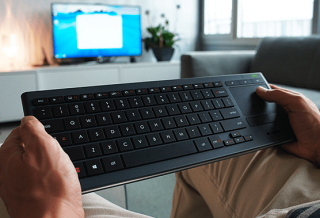Si está interesado en la realidad virtual (VR) y la realidad aumentada (AR), es probable que se haya hecho una o más de las preguntas que encontrará aquí. En muchos casos, no hay respuestas definitivas disponibles, pero les digo lo que pienso y lo que han dicho muchos de los principales expertos en los campos de la realidad virtual y la realidad aumentada.
¿Cómo me afectará la realidad virtual y aumentada?
¿Se pregunta cómo afectarán su vida las tecnologías de realidad virtual y realidad aumentada? No estás solo. Muchos se preguntan lo mismo y el futuro es incierto, por lo que cualquier respuesta a esta pregunta implicará algunas conjeturas.
La buena noticia: ni la realidad virtual ni la realidad aumentada se le impondrán de mala gana en un futuro próximo. No espere venir a trabajar mañana y descubrir que su PC ha sido reemplazada por completo por un par de anteojos AR.
Es probable que la realidad virtual comience a filtrarse en su vida por los bordes. Una sala de juegos de realidad virtual puede surgir en su centro comercial local, o un amigo con mentalidad tecnológica puede tener unos auriculares para que los experimente. A medida que comienzan a llegar los auriculares de menor costo, es posible que incluso decida comprar uno usted mismo. Mucho depende de la industria que trabaje, pero parece poco probable que VR forzar su camino en su vida como trabajar tanto como poco a poco su camino a través de las experiencias basadas en la localización, entretenimiento y juegos de azar.
La RA tiene el potencial de ser más disruptiva y sus puntos fuertes la convierten en un competidor para ser implementada en el lugar de trabajo antes que la RV. Al igual que en los primeros días de la computadora personal, esa puede ser la primera exposición de muchos usuarios a la tecnología. Sin embargo, es probable que el uso de la industria a gran escala esté ausente. A menos que se dé un gran salto hacia adelante para la RA (y dependiendo de su industria), es probable que todavía le falten al menos cinco años para pasar a colegas que lucen gafas de RA en lugar de una PC.
Las industrias de la realidad virtual y la realidad aumentada son todo menos estáticas, y el crecimiento puede llegar a pasos agigantados. Sería una tontería hacer una predicción sobre cualquiera de las industrias sin revisar constantemente esa predicción para realinearla con la realidad. Oculus dio la vuelta al mundo de la realidad virtual en 2013 con el DK1. HTC lo hizo de nuevo con Vive en 2016. Google y Apple dieron la vuelta al mundo de AR con ARCore y ARKit en 2017. Magic Leap espera hacer lo mismo con Creator Edition en 2018. Eso es un montón de vueltas y vueltas. La única constante es el cambio, por lo que mantenerse al tanto de los cambios es de vital importancia si no quiere quedarse atrás.
¿Qué tecnología ganará?
Una pregunta popular ahora que tanto la RV como la RA han aumentado en la conciencia pública es qué tecnología ganará la batalla de la cuarta ola de tecnologías: ¿ RV o RA ? Desde un punto de vista empresarial, es posible que desee saber qué tecnología utilizar para sus recursos de desarrollo. Desde el punto de vista del consumidor, es posible que desee saber qué dispositivos debería considerar comprar.
Una respuesta realista es que, a largo plazo, es probable que ambos ganen (es decir, que se conviertan en una parte integral de nuestras vidas tecnológicas). La realidad virtual y la realidad aumentada son tecnologías diferentes. Aunque existen en la misma esfera, no compiten directamente entre sí. Es probable que no haya un ganador y un perdedor. Ambos tienen diferentes conjuntos de fortalezas y debilidades. En el futuro, un usuario puede usar sus gafas de realidad aumentada en el trabajo para completar sus tareas diarias y luego volver a casa y ponerse sus gafas de realidad virtual para divertirse por la noche.
Dicho esto, el factor de forma definitivo puede ser un auricular que pueda fusionar las dos tecnologías. Ningún dispositivo actual ha ofrecido esta opción, aunque muchos cascos de realidad virtual tienen varias cámaras frontales que posiblemente podrían usarse para experiencias de realidad aumentada. Microsoft incluso llegó a nombrar sus cascos de realidad virtual como Windows Mixed Reality, lo que llevó a muchos a especular que Microsoft prevé que las tecnologías se fusionarán en un solo dispositivo en el futuro. (Por su parte, Microsoft ha afirmado que el nombre se debe a que sus auriculares pertenecen a su plataforma Windows Mixed Reality, que incluye los HoloLens).
Un auricular inalámbrico que ofrezca la capacidad de cambiar entre la inmersión total de la realidad virtual y los mundos mixtos de la realidad aumentada podría ser una solución a la que los consumidores acuden en masa.
¡La realidad virtual y la realidad aumentada no son necesariamente competidores! Cada uno tiene su propio conjunto de fortalezas, y las fortalezas de cada tecnología en realidad sirven para apuntalar las debilidades de la otra.
¿Qué pasa si no tengo un visor de realidad virtual o realidad aumentada?
Algunos sitios web utilizan WebVR (una forma de experimentar la realidad virtual en un navegador) y algunas aplicaciones le permiten usar su computadora o teléfono sin auriculares. YouTube, por ejemplo, tiene varios videos que le permiten mirar a su alrededor y explorar en 360 grados. Sin embargo, en esas aplicaciones, realmente no estás experimentando la realidad virtual. Solo está viendo un mundo de 360 grados a través de una pantalla bidimensional.
Para experimentar realmente la realidad virtual, se requieren auriculares. Varios auriculares básicos, como Google Cardboard, le permiten experimentar la realidad virtual a un costo muy bajo (a menudo, menos de $ 20). Dicho esto, debes buscar la mejor experiencia de realidad virtual que puedas. No es necesario que se apresure a comprar los auriculares VR más caros que pueda encontrar. Pero encuentre una experiencia de realidad virtual basada en la ubicación, o incluso pruebe en su centro comercial local o en un gran minorista que tenga áreas de demostración de realidad virtual. La diferencia de calidad entre un simple visor de Google Cardboard y los auriculares de gama alta es enorme. Si aún no ha experimentado la realidad virtual de alta calidad, es una experiencia increíble que no debe perderse.
Para experimentar una versión reducida de AR, a menudo todo lo que necesita es una versión reciente de un teléfono móvil o tableta Apple o Android. iOS y Android han lanzado ARKit y ARCore , versiones de AR creadas específicamente para sus respectivos dispositivos móviles. Existen varias aplicaciones en App Store y Google Play Store adaptadas a esas tecnologías.
¿Qué tamaño tendrán los mercados de consumo de realidad virtual y aumentada?
Es difícil precisar los tamaños de mercado actuales de la realidad virtual y la realidad aumentada en la actualidad, y mucho menos saber qué sucederá con esos mercados en el futuro. El tamaño del mercado es difícil de determinar por muchas razones, incluida la falta de disponibilidad de análisis de mercado precisos, diversas ejecuciones de factores de forma y fragmentación del mercado. Sin embargo, podemos mirar algunos productos y tecnologías para ayudar con algunas estimaciones aproximadas.
Para la realidad virtual, ahora es el momento perfecto para evaluar la dirección en la que se dirigen los mercados. La primera generación de dispositivos ha tenido mucho tiempo en manos de los consumidores. Están disponibles varios dispositivos de realidad virtual de segunda generación. También habrán surgido más detalles sobre los planes de los fabricantes para el futuro, y cómo se están ajustando al rumbo que parecen dirigirse los mercados.
All of this should add up to informative years for VR. Manufacturers appear to be planning for a sharp uptick in VR headset sales, with sales likely concentrated around the midrange headsets. The sales of these second-generation devices should help predict the size of the consumer base for VR. There may or may not be a massive explosion of VR adoption, but most hope that a steady increase over time in the quality of headsets and experiences should bolster the market.
AR will likely not see much of a consumer jump for a few years, outside of executions within mobile devices. Most AR devices are targeted toward enterprise businesses instead of consumers. If your dream was to sell a billion headset-based AR apps in the next few years, you’re likely to be disappointed. But fear not! What headset-based AR will lack in market size, it will make up for in enterprise-level executions. There will likely be a large influx of companies looking to utilize AR within the next few years.
You can typically extrapolate predictions based on existing markets, consumer price point comfort, and ability to scale to mass-consumption level. Generally, those data points give you enough information to make a reasonable guess at market size within the next year or two. However, there will always be the potential for a game-breaking technology to appear. A company could release a mass-produced AR headset tomorrow that immediately blows these predictions out of the water.
When should I enter the virtual reality/augmented reality market as a consumer?
There is no “right” or “wrong” time to enter the VR or AR marketplace. Evaluate each technology on its merits and decide what is right for you.
VR is, at present, a more mature market on the consumer side than AR. There is more competition among headset manufacturers and more content available via various manufacturers’ app stores. There are also a number of choices at various levels of quality and price points.
AR, on the other hand, lags behind in the consumer space. Only one or two headset/glasses manufacturers seem to be in any sort of position to produce hardware at anywhere near mass consumer scale, and the price points of these devices are far beyond what most consumers are willing to pay. However, users can also get a taste of AR via applications for their mobile devices.
In the end, this is a decision you must make on your own, considering how you plan to use the hardware and software. Are you looking for the highest-quality immersive experience for gaming or entertainment? A higher-end VR headset may be a good choice. Are you looking for a bleeding-edge, early adopter glance at how we could be working in the near future? Perhaps one of the AR headsets is your best bet.
For most of the general population, AR headsets at consumer scale is probably a few years out. Experiencing AR via your mobile device will likely suffice for most consumers for the time being.
VR, however, is readily available for public consumption now. If you have an interest in experiencing VR in the comfort of your own home, there is no reason to hold back any longer from purchasing a device. As with most tech hardware, at this point it’s just a matter of evaluating the hardware and upcoming choices and deciding what’s right for you.
When choosing a VR/AR device (or any technology), evaluate not only the current choices, but the upcoming choices as well. For example, a user looking for a VR device may be focused on the current generation of devices. As with many technologies, these devices are likely refreshed and improved upon every few years. Be sure to evaluate your current choices versus all upcoming choices to help avoid any buyer’s remorse.
When should my company enter the market?
There is no right or wrong time to enter the emerging technology market as a consumer, but there can be a right or wrong time to enter it as a company. Enter too early or without a strong direction, and you risk being so far out on the bleeding edge that the market hasn’t built itself to sustain your entry. Enter too late, and you risk the market having passed you by.
Now is definitely a good time to be evaluating both technologies to determine how they fit within your organization’s long-term growth and development. VR is fast maturing as a market. In the next two years, you can expect to see rapid growth in this space at mass consumer and enterprise scale.
AR is lagging behind slightly in availability for mass consumer adoption. Mobile AR will play a large role for the next few years, with AR wearables likely a few years beyond that. However, AR is already catching on within enterprise lines of business. AR in the enterprise will likely see very steady growth, with the potential for extreme spikes in certain enterprises such as medical, industrial, design, and manufacturing fields.
In general, the drawbacks of incorporating technology within your market too early pale in comparison to those of entering a market too late. Although you may jump the gun and find yourself with a smaller market by entering too early, you may find your market cornered by competitors if you enter too late.
You should already be evaluating how these technologies could shake up your particular industry. If you still aren’t sure how these technologies may fit within your industry, running one or two small pilot projects or ideation labs utilizing VR or AR within your company walls could help you decide where VR or AR adoption within your industry could take place in the future.
William Shakespeare wrote, “Better three hours too soon than a minute late.” The penalty your company will pay for entering the market too early is rarely higher than the steep price it could pay for entering the market too late. we all would love the ability to time the market just right, but that’s impossible. Err on the side of being proactive instead of reactive.
Which virtual reality headset is right for me?
Deciding upon a VR headset is a question with a number of variables involved — there is no one right answer that will work for everyone. At a high level, there are three different tiers of VR hardware:
- High-end “desktop” headsets: If you’re looking for the most immersive VR experience and have external hardware ready to power your headset, one of the high-end headsets is likely appropriate for you. These headsets offer the most immersive VR experience consumers can purchase today. They typically run on external hardware such as a desktop computer. Offloading the processing work to a desktop computer allows for a graphically intense experience because of the desktop PC’s powerful processor and memory availability. High-end headsets can also allow for freedom of motion with room-scale tracking and feature-rich external controllers. Most have a very strong selection of immersive games and entertainment selections.
The drawbacks of the higher-level headsets include price and the reliance on an external computer to power these experiences.
Current examples of high-level headsets include the Oculus Rift, HTC Vive Pro, and Windows Mixed Reality headsets.
- Mid-tier mobile headsets: The mid-tier (or mobile-powered) headsets offer a solid VR experience at a much lower price than the high-level experiences. Most of these headsets do require external hardware, but only a mobile phone that adheres to the VR device’s requirements, many of which consumers may already have. (The upcoming generation of mid-tier headsets include devices such as the HTC Vive Focus or Oculus Santa Cruz, which will be standalone and not require an external device.) Because these devices do not require a desktop computer, these headsets are far more portable. Without a reliance on tethering to an external piece of hardware or any extra sensors, these devices can be carted anywhere.
The drawback of these mobile experiences is the level of experience offered. With the limited computational power of mobile devices, the level of immersiveness can be less than that of the high-end headsets. The first generation of mid-tier devices does not offer the same fidelity of tracking the user, and the controllers are often fairly simplistic compared to the high-end options.
The mid-tier headset is often a good starter level for users intrigued by VR but not yet willing to go all in on a high-end device. They enable users to experience a taste of VR at a lower price point.
Current examples at this tier include the Samsung Gear VR and Google Daydream.
- Low-end mobile headsets: Low-level headsets consist mainly of Google Cardboard and devices built around the Google Cardboard specification. These low-end devices are powered with separate mobile hardware, which makes them easily portable.
Unlike the mid-tier devices, most of these low-end devices do away with niceties like controllers or other separate hardware and software integrations. The hardware and software experience is as bare bones as you can get while still remaining “VR.” These devices are often referred to as “viewers” — a good name for them, because they’re mainly built for viewing VR experiences and worlds, with very little interactivity.
Current examples include Google Cardboard, View-Master VR, and SMARTvr.
These low-level headsets are good as a way of democratizing VR experiences. Cardboards are relatively inexpensive, so they can be branded and shipped to consumers at a low cost. The New York Times did just that, shipping out over a million branded Google Cardboards and access to their NYT VR app to their customers. Similarly, Cardboard hardware may be a good choice where replacement cost or user damage is an issue, such as within elementary schools looking to experience VR without breaking the bank.
There is no “wrong” choice of VR headset. Just as your mobile phone is different from your TV, the mid-tier headsets have a different set of strengths and weaknesses than the high-end headsets. As a simple analogy, you may love watching a football game on your 60-inch flat-screen TV at home, but you can’t carry your 60-inch flat-screen everywhere you go. The portability your mobile phone offers can be a huge benefit, and you may find you end up spending even more time on your phone than in front of your TV, even though your TV offers an arguably “better” experience.
As the saying goes, “You get what you pay for.” VR in Google Cardboard is a great, low-cost introduction to VR, but don’t think that if you’ve used a Google Cardboard you’ve experienced the level of immersiveness VR can offer. The difference in experience from a Google Cardboard to a high-end VR experience can be the difference between watching a feature film on your mobile phone and watching it in a theater with full surround sound.
For AR experiences, there is little reason to purchase a headset right now for consumer consumption. The market for consumer-based AR applications and use cases outside of mobile AR aren’t yet at a critical mass. However, there are plenty of reasons to purchase AR headsets to create applications targeted toward enterprise-level consumption. For example, if you’re tasked with building an AR application for commercial or industrial usage. These fields will likely experience tremendous growth in usage of AR. You should evaluate the specific customer needs within that space and find the AR headset that aligns most closely with the requirements of that task.
With both Oculus and HTC releasing dedicated untethered devices in 2018, and Magic Leap scheduled to release hardware within that same timespan, make sure to compare the latest set of apples to apples when purchasing any VR or AR devices. The market is constantly in flux, so make sure to find the device whose strengths align with your project’s needs.
What could impede the growth of virtual and augmented reality?
The growth of these two technologies seems inevitable, but there are potential bumps in the road you should be aware of that could potentially throw one or the other off track.
VR seems to have made it through its Trough of Disillusionment. Short of studies finding massive health risks within VR, there is likely little to impede its growth at this point. The worst-case scenario for VR would seem to be sluggish growth. If the second generation of headsets gets a lukewarm consumer reception, or if the headset and application market becomes more fragmented and confusing, VR’s growth as a mass consumer device could slow down. It wouldn’t be the death knell for VR, but sluggish market growth can mean less investment capital. Less investment capital can create a feedback cycle of slower improvements, leading to sluggish growth, which leads back to slower improvements.
AR’s growth, outside of executions on mobile, is more constrained at the moment. Limited availability of hardware to developers can create lack of development resources, which can lead to lack of depth of content. The high price point of headsets, nonexistent content ecosystem, and no standardization of experience expectations when using AR are all things AR will struggle with over the next few years.
Are there lasting physical effects to using virtual and augmented reality?
Muchas tecnologías emergentes se han enfrentado a la perspectiva de posibles cuestiones médicas. Cuando las computadoras se estaban convirtiendo rápidamente en dispositivos de consumo masivo, los expertos médicos cuestionaron los efectos que el mirar las pantallas de las computadoras durante todo el día podría tener en nosotros a largo plazo. Cuando los dispositivos móviles comenzaron su ascenso a la conciencia pública, las preocupaciones sobre la radiación electromagnética de los propios teléfonos y las torres de telefonía móvil hicieron que los investigadores médicos estudiaran la relación entre la radiación de los teléfonos móviles y las tasas de cáncer.
El mismo tipo de preguntas existen actualmente para la realidad virtual y la realidad aumentada. ¿Tener una pantalla tan cerca de nuestros ojos causará un daño duradero a nuestra vista? ¿Trabajar a largo plazo en realidad virtual puede causar náuseas duraderas? ¿Podría haber efectos duraderos en el comportamiento de permanecer en estos mundos virtuales durante un período prolongado de tiempo?
Se cree que muchos de estos efectos médicos son poco más que problemas a corto plazo, pero aún no se han realizado estudios a largo plazo que evalúen el uso de la RV o la RA.
La mayoría de los expertos están de acuerdo en que, por el momento, puede ser cauteloso y sensato acerca de los riesgos potenciales, pero esa precaución no debería impedirle utilizar la tecnología como mejor le parezca. Quítese los auriculares si siente náuseas y tome “descansos de pantalla” cada media hora para que su vista tenga tiempo de reajustarse al mundo real. Todas estas son reglas estándar que ya debería seguir con respecto a cualquier tiempo de pantalla (auriculares VR, pantallas de computadora o dispositivos móviles).
¿Cuál es el futuro de la realidad virtual y aumentada?
Todas las tecnologías transformadoras tienen potencial positivo y negativo. Debido a su capacidad de inmersión, la realidad virtual probablemente sufrirá muchos de los mismos problemas que experimentan otras tecnologías en la actualidad, pero en mayor grado. Algunos de los problemas potenciales de esta nueva tecnología incluyen la adicción a la realidad virtual; usuarios que salen del mundo real y pasan demasiado tiempo en el virtual. El potencial de insensibilizar a los usuarios a sus acciones en el mundo real debido a la falta de consecuencias de sus acciones en el mundo virtual es un tema que también se ha citado.
La realidad aumentada podría sufrir algunos de los mismos problemas con los que la realidad virtual puede tener problemas. También podría lidiar con algunos problemas propios. ¿Quién posee los derechos del mundo digital? ¿Alguien debería tener la capacidad de mostrar contenido AR en cualquier lugar? ¿Podrían nuestras experiencias de RA volverse demasiado realistas? ¿Podríamos volvernos incapaces de distinguir el mundo real de las mejoras virtuales?
Estas son preocupaciones o proyectos de pensamiento interesantes, pero el enorme potencial de estas tecnologías los supera enormemente.
La realidad virtual tiene la capacidad de traspasar fronteras y fronteras. Internet conectó a las personas como nunca antes. La realidad virtual toma ese poder y agrega la capacidad de formar un espacio social global verdaderamente empático. Tiene la capacidad de revolucionar por completo la forma en que aprendemos y jugamos, y quizás lo más importante, cómo nos conectamos entre nosotros.
La RA tiene la capacidad de mejorar nuestras acciones diarias dentro del mundo real. Tiene el potencial de ayudar a las personas a tomar decisiones más inteligentes a través de la disponibilidad de información. Puede hacer que el mundo que nos rodea sea interactivo. Puede facilitar la creación de nuevas conexiones con otros a través de experiencias compartidas y cambiar la forma en que trabajamos actualmente. Usted nombra la industria, y dentro de diez años, AR puede haber transformado masivamente esa industria tal como la conocemos.









